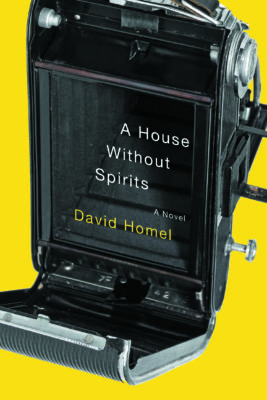Passing glances are the default mode of appreciating visual arts. Walk a little, stop, then move on to the next framed masterpiece, perhaps after a selfie. Especially with contemporary art, staying on top of trends can matter more than patient unpicking.
Why, then, do we sometimes backpedal from having seen to seeing again? Because a part of us gets entangled with the works we appreciate, suggests A House Without Spirits, David Homel’s novel about a forgotten photographer. Appreciating art is an ethical gesture. We bring our emotions, memories, or values to the party, and our response to art is also about ourselves. This ethics involves the people depicted as well, especially if the medium is photography; more so in civil law jurisdictions like Quebec, where individuals have a right to their image.
A House Without Spirits Esplanade Books
David Homel
$21.95
paper
220pp
9781550656060
Paul attempts to solve the surface enigma of an artist refusing fame, which proves at its heart to be the deeper enigma of his own memories. Because of Marchuk, he bites into, so to speak, his shit madeleine. Paul’s first-person account of his inquiry into the photographer’s life and work is inset with many stories from his own past. One of these stories is triggered by the powerful stench of the hoarder’s home. As a young kid, Paul encountered the limits of caring. His mother had to clear the apartment of a deceased relative of his father, who was unable to stand up to the task. The house was filled not only with useless objects, but also its owner’s excrement in bags. Only by remembering this episode does Paul realize the man was his father’s unavowed brother, and find the trauma of Eastern European families behind the façade of masculinity.
In fact, I remember David Homel telling me the exact same story, many years ago, at a Salon du Livre. I was a grad student asking him about The World is a Document (2002), the essay he had written about Montreal photographer John Max. In my notes, I noticed the choking in his voice as he compared the smell in Max’s home to that of his deceased uncle’s. The home can be seen in the movie John Max: A Portrait (2010). Homel’s emotion is footnoted in my thesis on Max’s photobook Open Passport (1973); because I am turning it into a monograph, I briefly feared the Borgesian paradox of reading myself as Homel’s protagonist.
Marchuk is Max; Paul is Homel, and so on, but the correspondences are not the point of this novel, even though there are some delightful ones about life in Mile End. A photograph may be of someone, Marchuk argues, but it might not have anything to do with them. What Homel does in revisiting the act of writing is to draw our attention to the politics of looking a second time. Paul’s interlocutors are his reconstituted family, his sons and his current partner. By questioning the stories he tells about himself and others, they complicate his sense of identity, empathy, and ethics. He responds with paradox. The bravura that made him, as a young Jewish kid, roll under moving freight train boxcars for fun could be reinterpreted as ethnic trauma of late capitalism; but what if it wasn’t felt as such back then? What if trauma was also a consequence of the words we use to label and make sense of events? Homel astutely subverts the relationship between signs and their meaning for both words and images.
Convincing enough people to look a second time is at the heart of canon formation. Take any venerable painter, and their history inevitably involves a contentious episode of rediscovery among scholars and critics. I can attest to the contention. Like Paul, I can also attest to the danger that faces the writer of speaking for someone else. Beware the forgotten genius saved from oblivion by a prescient critic: it’s a catcall to attract the passing glance. Most artists of interest do not fit this strident model, and Paul’s predicament is how to defend the moderate, but real, value of Marchuk.
This middle position is the fact of most lives, artists’ included. Paul finds his way out of Marchuk’s labyrinth without clamouring for his genius, but he cannot avoid feeling he saved someone either. This is the work of empathy, whereby we understand others by making puppet versions of them in our minds, like the titular spirits inhabiting Paul’s home. The aunt who was married to the excretion collector appears at his bedside a few times, commenting on his coming to terms with his uncle’s story. I would have called this a cliché, had I not myself experienced John Max’s visit in a dream after I had opened and sorted through his boxes.
What Paul’s story can lack in sheen or originality it compensates with insight and plenty of nuance. This is a novel that stays close to the texture of ordinary life rather than following the predetermined arcs of dramatic progression. It is documentary in the sense of Walker Evans’ photographs: not because it is true (which, legally speaking, it is not), but because it follows the form of information. Imagine, for example, a meandering conversation over a beer with someone who is trying to explain to you why they spent the last few months, or the last few years, working on a book about a half-forgotten Canadian photographer. It can only make sense if they are personally involved.mRb






0 Comments